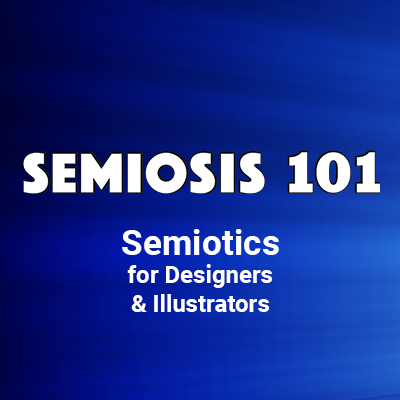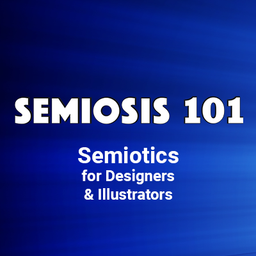Free Semiosis 101 Transcript 4.7:

How CAN CREATIVES HELP Audiences to Commit Their Attention?
Hello readers.
In this free transcript for the episode 4.7 published on Semiosis 101 on Weds 23rd July 2025, we focus on how you illustrators and designers are in a looping semiotic relationship with your audience. Your visual aesthetic does not change. It remains the same. Every meaning-bearing element in your visual language, remains within plain sight of your target audience just as it did before being perceived. The semiotically-encoded meaning only becomes meaningful to your audience at the mercy of their own perceptual abilities. Let us now explore this…
WeAreWaterloo’s Waterloo Food Fortnight 2019 festival examples used with kind permission of Hudson Fuggle © Hudson Fuggle 2019. Thanks to Ian Fuggle and Sarah Jane Chapman for their support.
www.linkedin.com/company/hudsonfuggle/
www.instagram.com/hudsonfuggle/
Watch the free episode on YouTube for the full impact…
…and here is the episode’s transcript.
How CAN CREATIVES HELP Audiences to Commit Their Attention?
If a semiotic sign is dormant until the audience interprets something they see as meaning something else, how do we ensure our audience takes the visual hook.
Yes, audiences and creatives are in a looping semiotic relationship. A concept needs to be visually communicated. You creatives represent that concept in how you design or illustrate. But will your audience successfully interpret? As Peirce says, nothing is a semiotic sign until it is interpreted as a sign for something else.
So, in this 7th episode of Semiosis 101’s season four, we focus on how you illustrators and designers are in a looping semiotic relationship with your audience. In the previous episode, I summarised how Semiosis is triggered when perception moves from dormant to action. Sign-action. Your visual aesthetic does not change. It remains the same. Every meaning-bearing element in your visual language, remains within plain sight of your target audience just as it did before being perceived. The semiotically-encoded meaning only becomes meaningful to your audience at the mercy of their own perceptual abilities.
In this episode, we explore how to apply Semiosis in your designs or illustrations, to facilitate FOR these necessary audience perceptual reactions. As creatives, it is important to understand that for an audience to perceive meaning, they draw on their lived experiences; as they have, “lived through their own history of conceptualizations.” In other words, how the audience interprets meaning is based on their lifeworld of previous knowledge and experience. Krippendorff states that, “every conception is someone’s conception.”
In pragmatism, pragmatists argue that everyone’s future interpretations are based on their own previous understanding. Knowledge is learnt whether by personal study or socio-cultural influences and consensus. By utilising a working Hypothesis of what your audience already visually understands, provides you with semiotic “hacks” straight to retaining their attention after triggering their perception. We can call this realisation second-order thinking
Pragmatic second-order thinking provides you illustrators and designers with a valuable edge, to semiotically enhance how you visually communicate. Your audience’s lifeworld helps you to form a working Hypothesis of what common experiences they all share. This valuable insight can be employed to semiotically “hack” your visual language during your ideation stages. By utilising qualities and visual references as a visual short-hand, you can align what you design or illustrate to what your audience can perceive as meaningful. This is just a small change in your existing creative mindset.
Semiosis’ power is rooted in the audience’s existing understanding OF something. Consider Sci-Fi or Fantasy worlds. Without our own existing experience of reality, these visions of fantastic worlds would not be imaginable. These flights of fancy that Sci-Fi and Fantasy creators take us on, are first built on what we have experience of. Establish that first and the audience will go with the flow.
Let me give you a creative example. London-based design agency Hudson Fuggle routinely produces the design work for WeAreWaterloo’s Waterloo Food Fortnight festival. WeAreWaterloo’s 2019 (the year before Covid hit) launch party theme was the 1990s. They gave the Hudson Fuggle team an open brief to visually communicate the 1990s to the Waterloo Food Fortnight audience. Any decade is diverse in culture, sub-cultures, music tastes (food tastes?) so the design team began Hypothesising what visual language would trigger recognition of the 1990s theme?
Mixtapes! The memory of bootlegging your own music-mixes. Hudson Fuggle Hypothesised that the general festival audience’s lived experience (over a certain age) was an audio cassette! Music triggers happy personal memories! Add a colour scheme hinting “Mr Blobby,” and the Waterloo Food Fortnight target audience instantly are back in the 1990s!
A working Hypothesis (Abductive reasoning) allowed the creatives to build meaning-bearing elements, which meant something to the target audience. Once perception was ‘hooked’ further visual communicated meaning would then be unlocked. By increasing your awareness of the tantalising insights your audience’s lived experiences can provide, you can improve how your aesthetic decisions retain your target audience’s attention. In season 2 and 3, I covered a lot of this theoretical semiotic grounding … so check out omnibuses 2.4 and 3.3.
“Lived experience” or a lifeworld is phenomenological. We all have lived experiences. When I use the term “lived experience” it immediately makes you realise your target audience are people, and not passive consumers. Yes, individually we all experience life differently However, collectively, we share commonalities of experiences, which are socio-culturally contextualised. Peirce’s Semiosis utilises this phenomena. Back in season 2, I used an example of how to use a working Hypothesis (Abductive reasoning) with an example target audience of cinema-goers.
In this example, I discussed semiotic qualities that would be familiar and provide a subconscious instant trigger to possible perception using cinematic darkness. My Hypothesis was that within the contextual lifeworld of cinema-goers, they feel comfortable with cinematic darkness. Therefore, a comfortable semiotic “hack” to gain and retain the audience’s attention, would be to use a tonal range of darker qualities in the visual language. This simple contextual “hack” semiotically strengthens the visual language to convey the client’s intended concept. Check out omnibus 2.4 for more on this example, and how to develop your existential awareness of working Hypotheses.
Lifeworlds and Hypotheses provide you with contextual insights to semiotically ideate. Whatever your client’s brief needs visually communicating, a small pragmatic change in your creative mindset can have you empathising more with your audience. My example of cinematic darkness to a cinema-going audience is just an Immediate example of a working Hypothesis. It is not the Final aesthetic design or illustration. The more you learn about your audience’s lifeworlds, the more tailored your ideation can be made to semiotically align with their experiences. If you want to read more about this then check out the Semiosis 101 Semiotic Resource on semiosis101.online. Link is below in the description.
Hypothesis (Abductive reasoning) is a logical way of beginning your ideation, so you can then semiotically encode effective meaning-bearing elements - semiotic signs. Hypothesis is the first level of logic and Abductive logic is referred to as the Logic of Design. Perception is key here. How you perceive crafting your visual language will pay dividends, to how your audience perceives what you design or illustrate. This is all within your semiotic control.
Without over-thinking yourself into ideation inertia, consider that all the raw marks, shapes, colours, etc. you sketch ARE potentially semiotically meaning-bearing. The qualities you sketch, even at an early thumbnailing stage, should be tailored to other people’s perceptions - NOT your personal tastes! There, I have said it. Once you change your creative mindset, you can sketch using possible qualities that your target audience will be familiar with. These contextual qualities are revealed from the audience’s lifeworlds.
From lifeworld insights you can Hypothesise how to enhance your chances of delivering instant audience perception - on their visual terms. Your sketches now are utilising Qualisigns! These qualities at the sketched ideation stage, will only ever be possible ways to weakly visually communicate the interpretive possibility of the intended concept in how you represent it. Peirce calls the delivery of these semiotic qualities Qualisigns. The lowest level a semiotic sign can take. We can think of Qualisigns as semiotically ephemeral. Once perception begins, the semiotic quality used to Immediately trigger audience attention is spent.
Semiosis can now begin to function, in interpretive cycles from simple to complex, in the mind of the audience. Your semiotically-encoded visual language represents the intended concept. Your semiotically encoded visual language aids the audience’s interpretation of what they see. With attention subconsciously perceived and retained; your visual language will release more meaning. Gradually the audience interprets their understanding of what that concept is from how you represent it.
You can help YOUR audience to commit their attention to your work, by semiotically framing your ideation’s initial sketches. By strengthening your visual language with familiar qualities, you can semiotically trigger instant possibilities for meaning in the mind of your audience. With that triggering of perception, the Qualisign’s instant delivery evaporates, and semiotic mediation of meaning begins in the form of a Sinsign (a sin-gle hit of contextual meaning)
In the next episode, I will discuss how to visually communicate deeper meaning by employing mediated semiotic sign-action in your illustrations or designs. Remember to subscribe to Semiosis 101 on YouTube to be notified when this next free episode is published. Or become a Semiosis 101 Producer on Patreon and watch all future episodes months ahead of YouTube …plus other exclusive Patreon-only video content.
Hint… hint…
Semiosis 101 Semiotic Design Resources is a reader-supported publication. To receive exclusive posts and support my work, consider becoming a free or paid subscriber. Paid subscribers get name checked on all future Semiosis 101 YouTube episodes.
===Semiosis 101 Patreon Producer==============
Become a Semiosis 101 Patreon Producer and get a named producer credit on future video episodes, plus watch all new episodes months ahead of YouTube.
===Semiosis 101 Patreon Exclusives==============
Watch longer Patreon-exclusive Semiosis 101 episodes on applying Semiosis into design and illustration…
PATEXC001 How does semiotics work in illustration?





